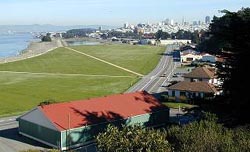
Crissy Airfield was established as a U.S. Army Airfield along the San Francisco Bay in 1919 and was the sole airfield in the United States to remain in constant operation between 1919 and 1936. It became the first Air Coast Defense Station established on the Pacific Coast. The airfield is named after Mayor Dana H. Crissy who lost his life while participating in an army test flight. Crissy Airfield is renowned as the site of many aviation firsts during the 1920s and for its connection with many notable aviation pioneers. The airfield is closely associated with Henry H. "Hap" Arnold, an important figure in World War II aviation who was appointed as the first Air Service Officer for the Western Department as well as the first commanding General of the Army Air Forces. Arnold was instrumental in the establishment of Crissy Airfield which was completed by 1921. Other notables associated with the airfield are Carl A. "Tooey" Spaatz, George H. Brett, and Delos C. Emmons, all important figures in the development of air power during the interwar years and World War II. Among its many notable events were the June 23,1924 dawn-to-dusk transcontinental flight performed by Lt. Russell L. Maughn, and the first attempt to fly from the mainland United States to Hawaii, led by naval Commander John Rodgers, on August 31, 1925.
The field is located on the northern shoreline of the San Francisco Presidio facing the Bay and on the site of a previous landfill completed for a 1915 exposition. Crissy Airfield is the only intact Air Coast Defense Station airfield in the Nation with the majority of its associated buildings still remaining as well. The buildings associated with the airfield include administrative buildings, buildings used for storage/technological purposes, three massive hangars and housing quarters. The housing is located west of the former airstrip along the elevated bend of Lincoln Boulevard with breathtaking views of San Francisco Bay. The buildings were primarily constructed in the Spanish Colonial Revival style. By 1936, operations at Crissy Field were taken over by Hamilton Field in Marin County.
Visit the National Park Service Travel American Aviation to learn more about Aviation related Historic Sites.
Last updated: August 29, 2017
